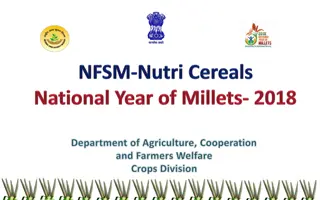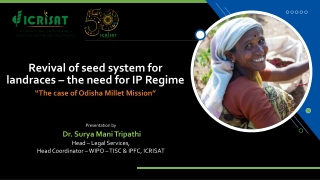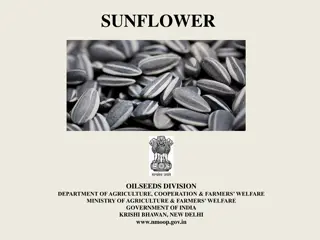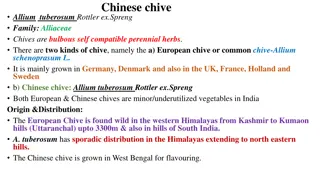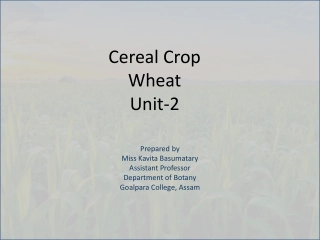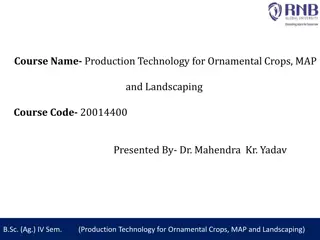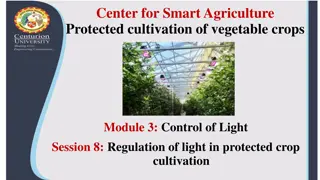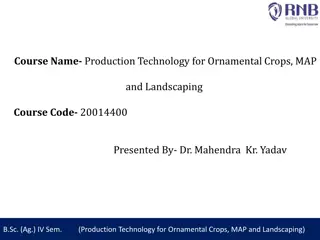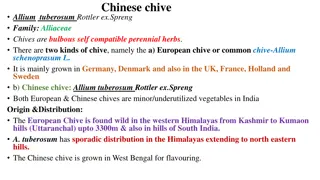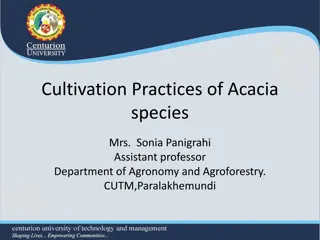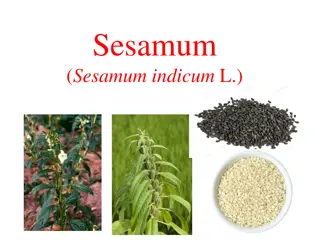Pearl Millet - Overview, Economic Importance, and Cultivation
Pearl millet (Pennisetum glaucum L.) is a vital coarse grain crop, known for its drought tolerance and nutritional value. Also called bajra, it serves as staple food, poultry feed, and cattle fodder. Originating from Africa, pearl millet is widely cultivated in semi-arid regions of India, Africa, and Asia. India leads global production, with key cultivation zones categorized by rainfall and soil types. The crop plays a crucial role in food security, especially for marginalized communities.
Download Presentation

Please find below an Image/Link to download the presentation.
The content on the website is provided AS IS for your information and personal use only. It may not be sold, licensed, or shared on other websites without obtaining consent from the author. Download presentation by click this link. If you encounter any issues during the download, it is possible that the publisher has removed the file from their server.
E N D
Presentation Transcript
PEARL MILLET Scientific name: Pennisetum glaucum L. Family: Poaceae (previously known as Gramineae) Chromosome number: 2n = 14 (Diploid species) Mr. Triptesh Mondal Assistant Professor Department of Agronomy M.S.S.S.O.A., C.U.T.M.
Economic importance and uses: Pearl millet is also known as Cat tail millet, Candle millet, Spiked millet, Bulrush millet, Dark millet, Bajra etc. Bajra is one of the major coarse grain crops and is considered as poor man s food. It provides staple food for the poor in a short period in the relatively dry tracts of the country. It is one of the most drought tolerant crops among cereals and millets. Pearl millet is endowed with greater ability to withstand harsh climatic factors and still yield substantially. The grain of bajra is superior in nutritive value to sorghum grain but inferior in feeding value. Pearl millet grains contain about 12.4% moisture, 11.6% protein, 5.0% fat, 67% carbohydrate, 2.7% minerals. It also contains a fairly high amount of carotene, riboflavin and niacin. Bajra grains are eaten cooked like rice or chapatis are prepared out of flour (like maize or sorghum), it is also used as poultry feed and green fodder for cattle.
Origin and Distribution: Most of the Scientists believe that the primary centre of origin of bajra is Africa from where it spread to India and other countries. It is cultivated mostly between 15 W and 90 E longitude and 5 S and 40 N latitude. Bajra is a warm weather coarse cereal grown mostly in semi-arid and arid climate of tropical and subtropical regions. It is widely grown in Africa and Asia. The important Bajra growing countries are India, Pakistan, China and south-east Asia. Over 94% of the pearl millet area in India is rainfed. Pearl millet has drought escaping mechanism instead of drought tolerant mechanism. So, the bajra plants cut short their life cycles and come to flowering early under severe drought condition.
1. India has divided into 4 ecological zones of pearl millet cultivation. Ecological Zone I: Adequate to abundant rainfall and light soils (Punjab, Uttar Pradesh, Delhi, Haryana and adjacent Madhya Pradesh). Ecological Zone II: Limited rainfall but heavy to loamy soils (Gujarat, Maharashtra and Madhya Pradesh). Ecological Zone III: Low rainfall and light sandy to sandy loam soils (Rajasthan, Karnataka and north-central Andhra Pradesh). Ecological Zone IV: Limited but well distributed rainfall (Tamil Nadu and coastal Andhra Pradesh). 2. 3. 4.
Area, Production and Productivity: Globally, pearl millet is grown in an area of 31.9 m ha with a total production of around 28 m tonnes and average productivity of 890 kg/ha. In India, pearl millet was grown in an area of about 7.54 m ha with total production of 10.36 m tonnes and average productivity of 1374 kg/ha (2019-20). In India, except West Bengal and Assam, it is grown throughout the country. It is generally grown in the areas of low rainfall and poor soils. Rajasthan, Maharashtra, Gujarat, western Uttar Pradesh and Haryana account for 87% of the total cultivated area of pearl millet in India. About 73% of the national production of pearl millet comes from these states. India is the largest producer of bajra in the world. In India, Rajasthan (45%), Uttar Pradesh (19%) and Haryana (10%) are 1st, 2ndand 3rdwith respect to production, respectively. Madhya Pradesh ranks 1stin the productivity of India, Haryana and Gujarat rank 2ndand 3rd, respectively in productivity .
Classification: Stapf (1934) divided the genus Pennisetum into 5 sections. These are: (a) Pennicillaria, (b) Gymnothria, (c) Eupennisetum, (d) Heterostachy and (e) Brevivalvula. The cultivated species of Pennisetum belongs to the section Pennicillaria distinguished from the species of other sections by the conspicuous Pennicillate anthers. Stapf included 32 species in Pennicillaria section. Out of 32 species found in Africa as described by Stapf (1934), six annuals are considered wild and probable ancestors of Pennisetum glaucum (pearl millet) and Pennisetum perpureum (napier grass/elephant grass). The cultivated species is believed to have originated through hybridization within these six wild annual species.
Botanical Description: The root system of pearl millet is fibrous. At the time of germination, a primary root develops from seed and penetrates deep in the soil. Primary root consists of several thin and fine lateral roots. When seedling reaches 2-3 leaf stage, the secondary/adventitious roots develop from the bud located on lowermost node near the soil surface. Some of the roots also arise from second and third nodes above the soil surface. Their primary function is to give anchorage to the plants. These roots are known as brace or prop roots. Tillers arise from the basal nodes. Stem: The stem is solid and usually single but often there are primary and secondary branches. It is made up of nodes and internodes. The nodes are slightly swollen, while internodes are cylindrical and glabrous. The lower internodes are completely covered with leaf sheath while upper ones are partially covered. A shallow groove is found above each node and the axillary bud is located in this groove. These buds give rise to leaves and sometime branches also. There is no bud on the uppermost node but it gives rise to floral stalk. Root system:
Leaves are long and fairly broad and held erect by thick midribs. Leaves are smooth on the lower surface and rough on the upper surface. Stomata is equally distributed on both surfaces. Leaves consist of leaf blades and leaf sheaths. The base of the leaf blade is slightly auricled and the ligule is short and membranous with a fringe of hairs. The leaf sheath is open, a little thicker than the leaf blade and encircles the stem almost completely. Inflorescence: The inflorescence is almost a cylindrical spike densely packed with the spikelets. The number of spikelets/spike varies from 800 to 3000. The length of the spike may vary from 15 to 60 cm. Spikelets usually occur in pair. Each spikelet consists of two glumes and two flowers. The lower flower being usually male and the upper one is perfect or hermaphrodite. The Kranz anatomy, a characteristic of C pathway in pearl millet makes it adaptive to drought and palatable for grazing cattle. Leaves:
The perfect flower is the 1stto appear. It has a lemma, thin palea, three stamens with characteristic pennicillate anthers and a carpel with two styles. 2-3 days after the emergence of the inflorescence, the bluish-white coloured styles begin to protrude out of the glumes. The remain receptive for 1-2 days. The anthers begin to emerge after the styles have started to dry up. Due to protogynous nature of the inflorescence usually cross pollination takes place. Caryopsis/Grain: The seed/caryopsis is almost oval with one of its end tapering. On an average, the seeds are 3-4 mm long and 2.0-2.5 mm wide. The colour of grain varies from whitish yellow to grey or dull light blue. The embryo has a reddish tinge. The embryo is small and located at the tapering end of the grain.
Soil requirement: Bajra can be grown on a wide variety of soils but being sensitive to water logging. It does best on well drained sandy loam soils and clay loam soils. Bajra is sensitive to acidic soils. It is grown successfully on black cotton soils, alluvial soils and red soils of India. Climatic requirement: Bajra is a rapid growing warm weather crop suitable for areas with 40-75 cm annual rainfall. The rainfall at flowering time is harmful as it washes off the pollen and consequently there is poor seed setting. The crop does best under light showers followed by bright sunshine. Pearl millet is grown as kharif crop in north India but with irrigation, it can be grown as a summer crop in Tamil Nadu, Karnataka and Punjab. The best/optimum temperature for the growth of bajra is between 30-35 C. Minimum temperature required for germination is 15 C and it can tolerate the maximum temperature upto 40 C.
Land preparation: The crop needs very fine tilth because the seeds are very small. It is essential to do the summer ploughing by mould board plough and after the onset of monsoon the field should be harrowed twice (or) thrice or ploughed by country plough. Care should be taken to remove all the weeds and stubbles from the field and if possible the field should be levelled and drains should be provided in the field. Seed and Sowing: Sowing time: Kharif: June July, Rabi: September October, Summer: First fortnight of January Avoid late planting beyond 15th July In case of delayed sowing, there is a drastic reduction in yield due to more incidence of diseases like downy mildew or ergot disease, restricted vegetative growth of the crop, high rate of seedling mortality and poor grain setting.
Seed Rate: 4.0-5.0 kg/ha in drilling, 2.5-3.0 kg/ha in dibbling & 2.0 kg/500-600 sq.m in nursery sowing to get seedlings for 1 ha area. Apply 25-30 kg CAN in nursery to give better start to the seedlings. Plant density of 175000-200000 plants/ha is optimum. Spacing: 45 cm R to R x 15 cm P to P Seed treatment: Seed should be treated with thiram or captan @ 3g/kg of seed. Method of Sowing: Broadcasting, Drilling, Dibbling and Transplanting. Of these, Drilling is most popular. Thinning and gap filling should be done at 10-15 DAS. Transplanting on main field should be done at 50 cm R to R and 10 cm P to P. Depth of Sowing: 2 to 3 cm Transplanting: Transplanting is done, in case, if sowings are delayed due to late onset of monsoon or heavy and continuous rains at the time of sowing. Transplanting gives higher yield as compared to direct sowing. 3-4 week old seedlings are planted @2 plants/hill. Under South Indian conditions, summer bajra is usually grown by transplanting.
Advantages of transplanting: Transplanted crop matures early (so, low temperature in the late season cannot create any adverse effect on seed setting) and produce more tillers and ears due to better growth. Transplanted crop gives higher yields than direct seeding/drilling. Optimum plant population is assured. Management of over aged seedlings: Transplanted crop matures early and produce more tillers and earheads due to better growth. In case of seedlings having age of less than 20 days, the tillers arise from the basal nodes just below the ground and most of the tillers put forth spikes at the same time. When aged seedlings are transplanted, tillers arise from the internodes above the ground . This makes the plant susceptible to lodging. To overcome this problem, the spike of the main culm is pulled nipped followed by top dressing of nitrogenous fertilizers and copious irrigation which induces profuse tillering from the basal nodes.
Manures and Fertilizers: Well decomposed FYM @ 5t/ha should be applied and mixed well into the soil about 20 days before sowing. Fertilizer schedule is as follows: Rainfed crop: 50 to 60 -30 -20 kg N-P O -K O/ha Irrigated crop: 100 to 120 60 40 kg N-P O -K O/ha Half dose of nitrogen, full doses of phosphorus and potassium should be applied at the time of sowing. The remaining half N is applied in 2 equal splits. Once at the time of thinning (3 to 4 weeks after sowing) and the rest at spike/ear formation stage. Water management: As bajra is a rainfed crop, there is hardly any need for irrigation. Irrigate the crop if there are no rains. Generally, two irrigations during the growing period of the crop are enough. If moisture is limiting, irrigation must be given at the time of earhead emergence (heading) because it is the most critical stage for moisture stress. Bajra does not tolerate water logging. So do not allow rain water to stand in the field for more than few hours. Proper arrangement for draining the excess water must be made. Total water requirement is 450-550 mm and W.U.E. is 8.0 kg/ha.mm of water.
Weed management: The damage due to weeds is severe upto 3-5 weeks after sowing. Intercultivations by hand hoe or wheel hoe should be done at 3-5 weeks after sowing. However, sometimes due to unavailability of labour or soil being too wet topermit manual wedding, timely weeding becomes difficult. Under such conditions the only effective way to control weeds is the use of herbicides. Pre-emergence application of Atrazine or Propazine @0.5 kg a.i./ha in 800 litres of water controls most of the monocot and dicot weeds. Harvesting and Threshing: Harvest the crop when grains become hard and contain about 20% moisture. Harvesting is done by cutting the entire plant or removing the earheads first and cutting down the plants later on. The earheads after harvesting, should be dried in the sun. The grains are separated either by beating the ear heads by sticks or by trampling by bullocks. The threshed grain should be cleaned and dried in sun to bring the moisture content down to 12% for safe storage.
Yield: For rainfed crop, grain yield is 1.2-1.5 t/ha and dry stover yield is 7.0-7.5 t/ha. For irrigated condition, grain yield is 3.0-3.5 t/ha and dry stover yield is 10.0 t/ha. Varieties: HYBRIDS: BJ-104, BK-560, BD-111, MBH-110, ICMH-451 COMPOSITES: VIJAYA, NAGARJUNA, ICTP -8203, BALAJI, VISAKHA, WCC-75, ICMV - 155, ICMV 221 SYNTHETICS: MUKTA, MALLIKARJUNA(PBS-1), APS-1 (ANANTHA), ICMS- 7703 Reasons for low yield of coarse cereals: Marginal lands are used for their production than other cereals They are confined to small production units They are often grown as intercrops Uncertain precipitation trends Limited commercial demand
Cropping Systems: Sequential cropping: Pearl millet - Groundnut Pearl millet - Cowpea Pearl millet - Pigeon pea Pearl millet - Barley Pearl millet - Wheat Pearl millet - Toria Intercropping system : Pearl millet + Groundnut Pearl millet + Cowpea Pearl millet + Pigeon pea Pearl millet + Castor Pearl millet + Sesame Pearl millet + Moong bean Pearl millet + Urd bean


